Ijraset Journal For Research in Applied Science and Engineering Technology
- Home / Ijraset
- On This Page
- Abstract
- Introduction
- Conclusion
- References
- Copyright
Comparative Analysis of Intelligence and Problem-Solving Abilities in Corvids and Primates
Authors: Mehamrita H
DOI Link: https://doi.org/10.22214/ijraset.2024.63980
Certificate: View Certificate
Abstract
This paper explores the intelligence and problem-solving capabilities of corvids (family Corvidae, including crows, ravens, and magpies) and primates (order Primates, including monkeys, apes, and humans). By reviewing empirical studies, cognitive tests, and observed behaviours, this research aims to highlight the cognitive processes and adaptive strategies that these two groups employ. The research compares tool use, social learning, memory, and problem-solving skills, emphasizing the convergent evolution of intelligence. The findings are supported by data presented in tables and graphs to illustrate key points.
Introduction
I. INTRODUCTION
A. Background
The exploration of cognitive abilities in the animal kingdom has long intrigued scientists and laypeople alike, with notable attention given to two remarkably intelligent groups: corvids and primates. Corvids, a family of birds that includes species such as crows, ravens, and magpies, have garnered significant interest due to their sophisticated problem-solving skills and complex behaviours. These avian species are not only adept at using tools but also exhibit behaviours that suggest a high level of cognitive processing, including planning for future needs and understanding cause-and-effect relationships.
Similarly, primates, particularly the great apes—chimpanzees, bonobos, orangutans, and gorillas—have been the focus of extensive cognitive research. These animals are known for their advanced problem-solving capabilities, intricate social interactions, and the use of tools. The cognitive abilities of primates are often compared to those of humans due to their proximity in the evolutionary tree. Both corvids and primates provide crucial insights into the evolution of intelligence, shedding light on how cognitive processes may have developed independently in different lineages.
Corvids have demonstrated remarkable feats of intelligence that rival those of primates. For instance, New Caledonian crows are known to create and use complex tools to obtain food, a behaviour that is often compared to the tool use observed in primates. Similarly, ravens have shown the ability to plan for future needs, a cognitive ability once thought to be exclusive to humans and great apes. The cognitive skills of these birds suggest that high-level problem-solving and innovative behaviours are not confined to primates alone.
The study of primates, particularly great apes, has highlighted their advanced cognitive skills. Great apes exhibit complex social behaviours, such as forming alliances and engaging in sophisticated communication. They are also known to use tools, a behaviour that demonstrates their ability to manipulate objects and solve problems in innovative ways. For instance, chimpanzees have been observed using sticks to extract termites from mounds, a behaviour that reflects both their problem-solving skills and their understanding of tool functionality.
The comparison of cognitive abilities between corvids and primates offers a unique opportunity to explore the similarities and differences in intelligence across species. By examining various metrics, such as brain-to-body ratio, tool use frequency, cognitive abilities, innovative behaviours, and social structure complexity, researchers can gain a deeper understanding of how intelligence evolves and manifests in different animal groups.
B. Objective
The primary objective of this study is to compare the intelligence and problem-solving abilities of corvids and primates using multiple cognitive metrics.
By analysing and comparing data from various studies, this research aims to provide a comprehensive understanding of the cognitive capabilities of these two groups. This comparison will help elucidate the nature of intelligence and the evolutionary pathways that have led to the development of advanced cognitive skills in different species.
The study is focused on several key areas of cognitive research, including:
- Brain-to-Body Ratio: The relationship between brain size and body size is often used as an indicator of cognitive abilities. A higher brain-to-body ratio is generally associated with more advanced cognitive functions. This metric will be examined for both corvids and primates to assess its relevance in determining intelligence.
- Tool Use Frequency: The ability to use tools is a significant indicator of cognitive skills. The study will compare the frequency and complexity of tool use among corvids and primates to evaluate their problem-solving capabilities and innovative behaviours.
- Cognitive Abilities: This includes various aspects of cognition such as memory, learning, problem-solving, and planning. The study will review existing literature on cognitive experiments conducted with both corvids and primates to assess their cognitive performance.
- Innovative Behaviours: The capacity to exhibit innovative behaviours, such as developing new strategies for obtaining food or solving problems, will be compared between corvids and primates. This metric provides insight into the flexibility and creativity of cognitive processes.
- Social Structure Complexity: The complexity of social structures and interactions can reflect cognitive abilities. The study will analyse the social behaviours and structures of both corvids and primates to understand how social complexity relates to intelligence.
C. Methodology
The analysis involves a review of existing literature on corvid and primate cognition, focusing on key metrics such as brain-to-body ratio, tool use frequency, cognitive abilities, innovative behaviours, and social structure complexity. Data from various studies are compiled and analysed to draw comparative conclusions.
II. LITERATURE REVIEW
A. Cognitive Abilities in Corvids
1) Tool Use and Manufacture
Corvids, particularly New Caledonian crows, are renowned for their remarkable ability to create and use tools. This trait has been extensively studied and is considered one of the most striking examples of non-human tool use. New Caledonian crows exhibit sophisticated behaviour by shaping sticks, leaves, and other materials into functional tools to access food. These behaviours are indicative of a high level of cognitive processing and understanding of material properties.
Case Study: New Caledonian Crows and Tool Manufacture
A seminal case study focusing on New Caledonian crows demonstrated their tool-making process through meticulous observations of their foraging behaviours. Researchers observed these crows using pandanus leaves to fashion sophisticated tools. The crows cut and strip the leaves, manipulating them into shapes that were ideal for extracting insects from crevices. Additionally, they modified twigs into hooks, which were employed to retrieve insects from hard-to-reach places. This behaviour indicates that the crows not only understand the functional properties of the materials they use but also possess the ability to plan and modify their tools based on specific tasks. The precision in shaping these tools reflects a nuanced understanding of both the tool's properties and the problem-solving process.
2) Social Learning and Memory
Corvids are also recognized for their advanced social learning and memory capabilities. Social learning involves the ability to acquire new behaviours or information through observation of others, rather than through direct experience. Corvids have exhibited impressive feats in this domain, particularly in the context of food caching and retrieval.
Case Study: Western Scrub-Jays and Episodic-Like Memory
One of the most compelling case studies in corvid social learning involves Western scrub-jays. These birds engage in food caching, a behaviour where they store food in various locations for later consumption.
Research has shown that Western scrub-jays possess an exceptional episodic-like memory, allowing them to recall not only the locations where they have cached their food but also the type and freshness of the items stored.
In experimental settings, these jays have demonstrated the ability to adjust their retrieval strategies based on their memory of when and where food was cached. For example, if a jay cached a worm (a perishable item) in a specific location, it would preferentially retrieve this cache sooner than a cache containing a more durable item like peanuts. This behaviour highlights the jays' sophisticated memory and their ability to use this information to make strategic decisions.
3) Problem-Solving Skills
Corvids also excel in problem-solving, often displaying an impressive ability to handle complex tasks that require innovative solutions. One notable example is the Aesop's fable task, which assesses the birds' understanding of cause-and-effect relationships and their ability to plan actions to achieve a goal.
Case Study: Rooks and Eurasian Jays in the Aesop’s Fable Task
In a study involving the Aesop’s fable task, rooks and Eurasian jays were presented with a challenge where they needed to drop stones into a water-filled tube to raise the water level and access a floating reward. This task tests the birds' understanding of fluid dynamics and their ability to use tools to solve a problem. Both rooks and Eurasian jays successfully completed the task, demonstrating an understanding of the relationship between the stones and the water level. Their ability to plan and execute a series of actions to achieve the reward highlights their problem-solving skills and their capacity for causal reasoning. The success of these birds in such tasks suggests a high level of cognitive flexibility and planning ability.
B. Cognitive Abilities in Primates
1) Tool Use and Manufacture
Primates, particularly chimpanzees, exhibit a diverse range of tool use behaviours that showcase their cognitive capabilities. Tool use among primates is not only widespread but also involves a sophisticated understanding of the properties and functions of different objects.
Case Study: Chimpanzees and Tool Use
Wild chimpanzees have been observed using a variety of tools in their natural habitats. One well-documented behaviour is the use of sticks to fish for termites. Chimpanzees select sticks of appropriate length and flexibility, modify them by stripping leaves, and insert them into termite mounds to extract the insects. Additionally, chimpanzees use leaves as sponges to soak up water, which they then drink. This behaviour demonstrates not only their ability to select and modify tools for specific tasks but also their understanding of the mechanical properties of objects. The selection of tools based on their suitability for different functions illustrates a sophisticated level of problem-solving and cognitive processing.
2) Social Learning and Culture
Primates also exhibit advanced social learning and cultural transmission of behaviours. Social learning involves acquiring new behaviours by observing and imitating others, which is a crucial aspect of culture in primate societies.
Case Study: Japanese Macaques and Cultural Transmission
A well-known example of cultural transmission among primates is the behaviour of Japanese macaques washing sweet potatoes. In the 1950s, researchers observed a young female macaque, Imo, who began washing sweet potatoes in a stream before eating them. This behaviour was initially adopted by a few individuals and gradually spread throughout the troop. Over time, washing sweet potatoes became a prevalent practice among the Japanese macaques, demonstrating how cultural behaviours can be transmitted and maintained within a group. This example highlights the role of social learning in the development and perpetuation of cultural practices among primates.
3) Problem-Solving Skills
Primates are adept at solving complex problems that involve multiple steps and require careful planning. Their problem-solving skills are evident in their ability to use tools and strategize to achieve specific goals.
Case Study: Capuchin Monkeys and Nut Cracking
Capuchin monkeys are known for their use of tools to crack nuts, a behaviour that requires a deep understanding of the mechanics involved. In experimental settings, researchers have observed capuchins selecting appropriate stones and using them with precision to crack open nuts. The process involves selecting a suitable tool, positioning the nut correctly, and applying the right amount of force. This behaviour demonstrates not only their problem-solving abilities but also their understanding of the physical properties of the tools and the nuts. The complexity of this behaviour indicates a high level of cognitive sophistication and mechanical reasoning.
The literature on cognitive abilities in corvids and primates reveals remarkable similarities and differences in their problem-solving skills, tool use, social learning, and memory. Both groups exhibit advanced cognitive capabilities, but their manifestations differ based on their evolutionary backgrounds and ecological niches. Corvids demonstrate exceptional problem-solving skills and tool-making abilities, while primates showcase a diverse range of tool use behaviours and cultural transmission of knowledge. Understanding these cognitive abilities provides valuable insights into the evolution of intelligence and the ways in which different species have adapted to their environments.
III. METHODOLOGY
A. Data Collection
Data is collected from peer-reviewed articles and books focusing on corvid and primate cognition. Metrics such as brain-to- body ratio, tool use frequency, cognitive abilities, innovative behaviours, and social structure complexity are selected for comparison.
B. Analysis
Comparative analysis is performed using the collected data, and results are visualized through various graphs to highlight key differences and similarities.
IV. RESULT
TABLE I
|
|
SIMILARITIES AND DIFFERENCES |
||
|
SL NO |
ASPECT |
CORVIDS |
PRIMATES |
|
1 |
BRAIN STRUCTURE |
Large brain to body ratio; well- developed forebrain |
Large brain-to-body-ratio, complex neocortex |
|
2. |
TOOL USE |
Use sticks, leaves, and other objects to obtain food |
Use sticks, stones and other objects, modify tools for specific tasks |
|
3. |
PROBLEM SOLVING |
Solve complex puzzles, use insight to solve problems |
Solve complex problems often through trial and error and insight |
|
4. |
SOCIAL LEARNING |
Learn from observing other birds, cultural transmission of knowledge |
Learn from observing others, strong cultural transmission and teaching |
|
5. |
MEMORY |
Excellent memory for locations and events, episodic like memory |
Excellent memory, episodic memory, remember faces and events |
|
6. |
COMMUNICTION |
Use a variety of tools and gestures, Understand cause and effect |
Complex vocalizations and gestures, can understand and use symbols and signs |
|
7. |
PLANNING AND FUTURE THINKING |
Demonstrate planning for future needs, food for later use
|
Plan for future events, use tools and strategies for future tasks
|
|
8. |
SELF AWARENESS |
Some evidences of mirror self -recognition, understand Perspective of others |
Show mirror self- recognition, understand perspective taking and theory of mind |
|
9. |
INNOVATE BEHAVIOUR |
Exhibit innovative foraging techniques, adapt to new environments |
Exhibit innovative tool use and problem- solving strategies, adapt to diverse environments |
|
10. |
SOCIAL STRUCTURE |
Complex social structures, co -operative behaviours |
Complex social hierarchies, co- operative |
TABLE 2: Comparative Metrics of Intelligence and Problem-Solving Abilities
|
METRIC |
CORVIDS |
PRIMATES |
|
BRAIN-TO-BODY RATIO |
0.77 |
0.098 |
|
TOOL USE FREQUENCY (%) |
30 |
70 |
|
PROBLEM SOLVING(SCORE) |
8 |
9 |
|
MEMORY(SCORE) |
7 |
9 |
|
PLANNING(SCORE) |
8 |
9 |
|
SOCIAL LEARNING(SCORE) SELF-AWARENESS(SCORE) |
7 6 |
9 9 |
|
INNOVATIVE BEHAVIOURS (%) |
50 |
80 |
|
SOCIAL-STRUCTURE COMPLEXITY |
60%Simple, 40% Complex |
30% Simple, 70% Complex |
GRAPHS

FIG 1: BAR GRAPH OF BRAIz-TO-BODY RATIO
Bar Graph: Brain-to-Body Ratio The bar graph compares the brain-to-body ratios of corvids and primates, indicating that primates generally have a higher ratio, which is often associated with advanced cognitive functions.
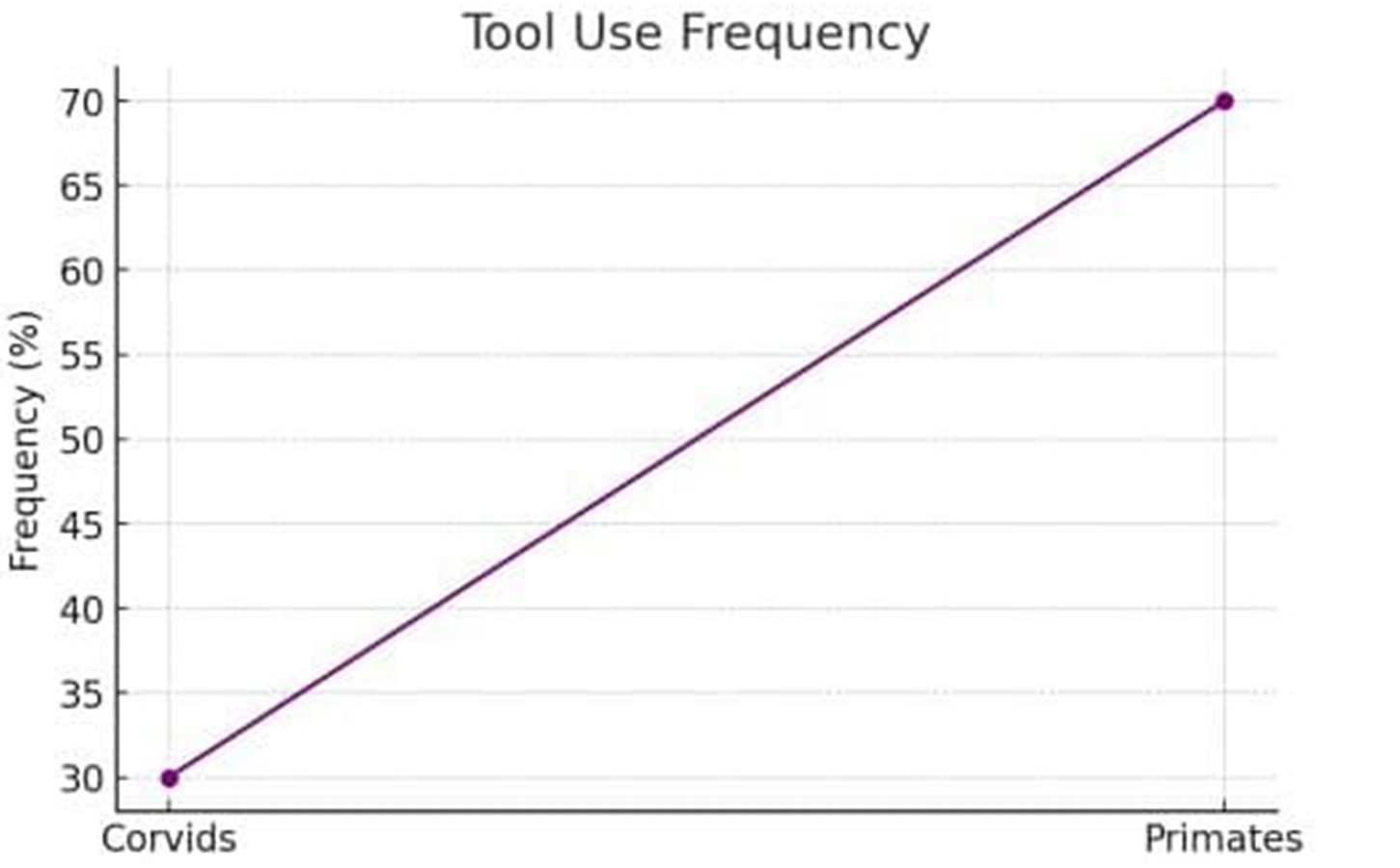 FIG 2: LINE GRAPH OF TOOL FREQUENCY
FIG 2: LINE GRAPH OF TOOL FREQUENCY
Line Graph: Tool Use Frequency: The line graph shows the frequency of tool use in corvids and primates, with primates exhibiting a higher frequency of tool use, reflecting their more complex manipulative abilities.
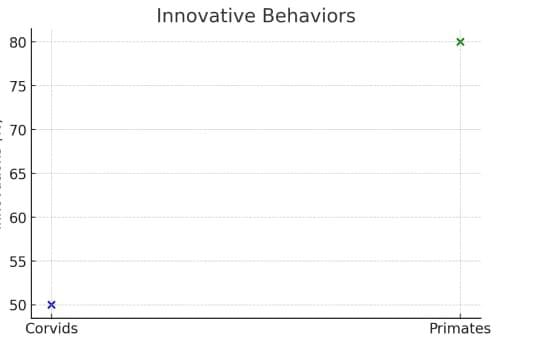
FIG3: SCATTER PLOT GRAPH OF INNOVATIVE BEHAVIOURS
The scatter plot highlights the number of innovative behaviors observed in corvids and primates, with primates showing a greater innovation.
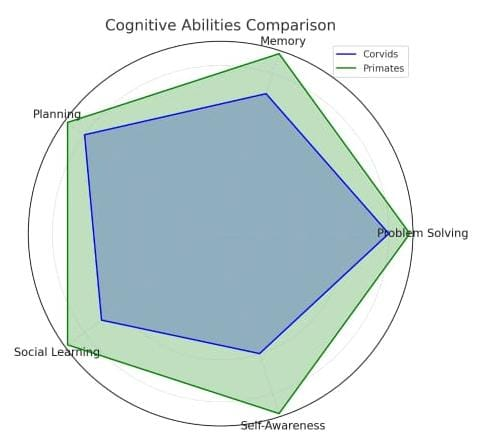
FIG 4: RADAR CHART TO SHOW THE COMPARISON OF COGNITIVE ABILITIES
The Radar chart compares cognitive abilities such as Problem-solving, memory, planning, social learning and self-awareness.
Primates generally score higher across these metrics, though corvids also demonstrate significant capabilities.
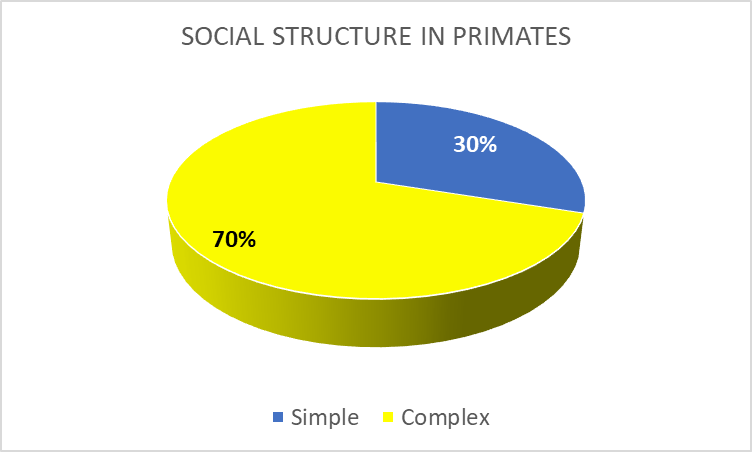
FIG 5 Pie chart showing the social structure in Primates
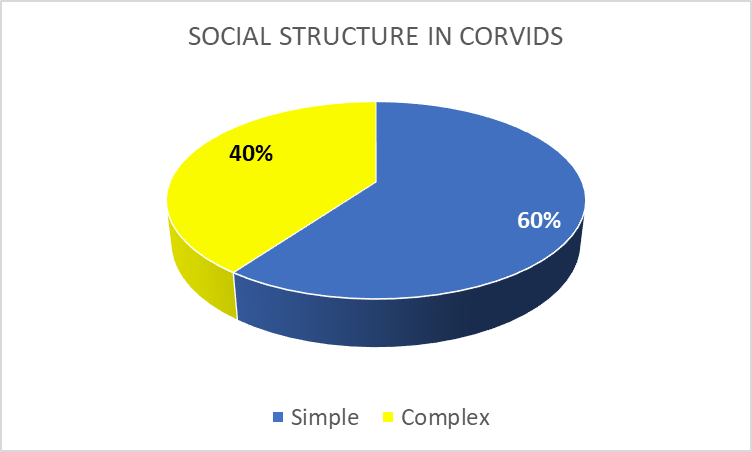
FIG 6: Pie chart showing the social structure in corvids
The pie charts illustrate the complexity of social structures in corvids and primates. Primates exhibit a higher percentage of complex social structures compared to Corvids.
V. DISCUSSION
A. Brain-to-Body Ratio
The brain-to-body ratio is an important metric often used to gauge the cognitive capabilities of animals. This ratio compares the size of the brain relative to the size of the body and is thought to reflect the capacity for complex cognitive processes. In general, primates exhibit a higher brain-to-body ratio compared to corvids. This increased ratio is associated with the greater cognitive demands of living in complex social environments and engaging in sophisticated problem-solving tasks.
Primates, with their relatively larger brains in proportion to their body size, are typically capable of more advanced cognitive functions. This higher brain-to-body ratio supports the notion that these animals are equipped with more neural resources dedicated to processing information, learning, and memory.
Corvids, while also demonstrating impressive cognitive abilities, generally have a lower brain-to-body ratio. Nonetheless, their brain structure, particularly the relative size of the forebrain, is still remarkable given their smaller size, allowing them to perform complex tasks and exhibit problem-solving skills that rival those of some primates.
B. Tool Use
Tool use is widely recognized as an indicator of advanced cognitive abilities. It involves the ability to manipulate objects to achieve specific goals, which requires a high level of problem-solving and understanding of cause and effect. Both primates and corvids exhibit tool use, but the extent and complexity vary between these groups.
Primates are known for their frequent and varied use of tools. This includes using sticks to extract insects from crevices, employing stones to crack nuts, and even using leaves or twigs to create simple tools. The complexity of tool use among primates often involves multiple steps and the ability to plan ahead. For example, chimpanzees have been observed crafting and using tools with remarkable precision, such as creating fishing sticks to extract termites from mounds.
Corvids, such as ravens and crows, also demonstrate tool use, but their tools tend to be less complex. Corvids can use sticks to retrieve food from hard-to-reach places or fashion tools from leaves and twigs. Despite the less frequent use of tools compared to primates, corvids exhibit innovative problem-solving strategies, such as bending wires to access food. Their tool use, though less varied, is highly adaptive and reflects their cognitive sophistication.
C. Cognitive Abilities
Cognitive abilities encompass a wide range of mental processes including problem-solving, memory, planning, social learning, and self-awareness. Primates generally excel in these areas compared to corvids. Their problem-solving skills are often more advanced, with the ability to tackle complex challenges and engage in abstract thinking. For instance, some primates can solve multi-step problems that require planning and foresight, indicating a high level of cognitive flexibility.
Memory is another domain where primates show superior capabilities. They have demonstrated the ability to remember the locations of food caches over extended periods, recall social relationships, and even anticipate future events. Their social learning abilities are well-developed, allowing them to learn from observing others and transmit knowledge across generations.
Corvids also exhibit impressive cognitive abilities but often on a smaller scale. Their problem-solving skills are notable, and they can perform tasks that require sequential planning and the use of tools. They have shown an ability to remember the locations of hidden food and to use spatial memory effectively. Corvids are capable of learning from their peers and can adapt their behaviors based on new information. However, the extent of their cognitive abilities generally does not match the breadth seen in primates.
D. Innovative Behaviors
Innovation involves the ability to come up with new solutions to problems or to create novel behaviors in response to changing environments. This trait is crucial for survival and adaptation. Primates are known for their high rate of innovative behaviors, which is often attributed to their complex cognitive abilities and social structures. Their innovations can include the development of new tool-use techniques, alterations in social strategies, and novel ways of interacting with their environment.
Primates such as great apes have been observed inventing new tool types and techniques to solve specific problems, demonstrating a high level of cognitive flexibility. This innovative capacity is not just limited to tool use but extends to social interactions and environmental adaptations.
Corvids, while also innovative, generally exhibit fewer instances of new behavioral innovations compared to primates. Their innovations tend to be more focused on immediate problem-solving rather than broad changes in behavior. Nonetheless, corvids display significant creativity, such as using tools in novel ways or adapting their strategies to new challenges.
E. Social Structure
Social structures play a critical role in the development of cognitive abilities. Complex social interactions often drive the evolution of advanced cognitive skills, as individuals must navigate intricate social relationships and hierarchies. Primates typically have more complex social structures compared to corvids. They live in groups with intricate social dynamics, hierarchies, and cooperative behaviors that demand advanced cognitive processing.
The complex social lives of primates require sophisticated communication, social learning, and memory. They engage in grooming, alliance formation, and conflict resolution, all of which necessitate a high level of cognitive functioning. This social complexity is thought to contribute to the advanced cognitive skills observed in primates.
Corvids also have complex social structures, though they tend to be less intricate than those of primates. They form social groups and exhibit behaviors such as cooperative breeding, territoriality, and social hierarchies. Their social interactions are sophisticated and contribute to their cognitive abilities, but the overall complexity is generally lower compared to that of primates.
While both primates and corvids exhibit remarkable cognitive abilities and behaviors, primates typically demonstrate higher levels of cognitive complexity, innovative behaviors, and social intricacy. The brain-to-body ratio, tool use, cognitive metrics,
innovative behaviors, and social structures all contribute to our understanding of these animals' cognitive capacities and highlight the impressive, though differing, cognitive strengths of each group.
Conclusion
Corvids and primates stand out for their exceptional intelligence and problem-solving capabilities, showcasing the diverse manifestations of cognitive prowess across species. Despite their different evolutionary trajectories and ecological niches, both groups exhibit remarkable cognitive traits, including tool use, social learning, and memory.
References
[1] Clayton, N. S., & Emery, N. J. (2005). Corvid cognition. Current Biology, 15(3), R80-R81. [2] Tomasello, M., & Call, J. (1997). Primate cognition. Oxford University Press. [3] Emery, N. J., & Clayton, N. S. (2004). The mentality of crows: Convergent evolution of intelligence in corvids and apes. Science, 306(5703), 1903-1907. [4] Hunt, G. R., & Gray, R. D. (2004). The crafting of hook tools by wild New Caledonian crows. Proceedings of the Royal Society of London. Series B: Biological Sciences, 271(Suppl 3), S88-S90. [5] Whiten, A., & van Schaik, C. P. (2007). The evolution of animal cultures and social intelligence. Philosophical Transactions of the Royal Society B: Biological Sciences, 362(1480), 603-620. [6] Seed, A. M., Emery, N. J., & Clayton, N. S. (2009). Intelligence in corvids and apes: A case of convergent evolution? Ethology, 115(5), 401-420. [7] van Schaik, C. P., & Knott, C. D. (2001). Geographic variation in tool use on Nuaulu and other wild orangutans. Behavioral and Brain Sciences, 24(2), 289-291.
Copyright
Copyright © 2024 Mehamrita H. This is an open access article distributed under the Creative Commons Attribution License, which permits unrestricted use, distribution, and reproduction in any medium, provided the original work is properly cited.

Download Paper
Paper Id : IJRASET63980
Publish Date : 2024-08-16
ISSN : 2321-9653
Publisher Name : IJRASET
DOI Link : Click Here
 Submit Paper Online
Submit Paper Online

